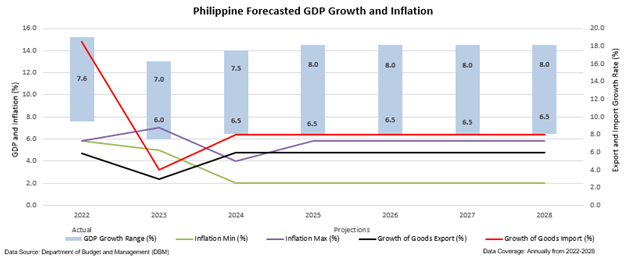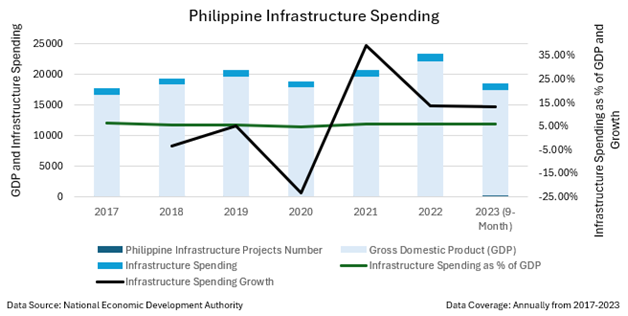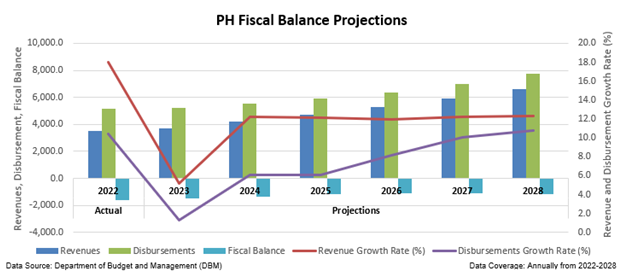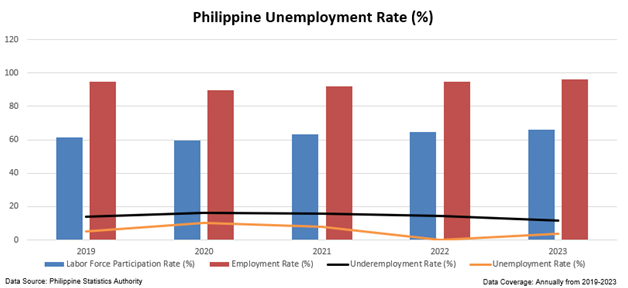PH MONDAY MACRO: Philippines foresees strong growth in 2024: Robust Economy, Infrastructure Boost, and Fiscal Management Optimism

With a focus on resilient domestic demand, stable market conditions, and employment, coupled with easing inflation and a commitment to infrastructure, the nation anticipates significant economic expansion.
Successful fiscal management, including new revenue measures, and a low unemployment rate further contribute to the positive outlook, making 2024 a promising year for the Philippines.
Philippine Markets Newsletter:
The Monday Macro Report
Powered by Valens Research
There are many things to look forward to in 2024.
Firstly, domestic demand is expected to continue driving growth with the resilient product consumption supported by stable market conditions and stable employment.
This is also supported by easing inflation with the December 2023 inflation rate of 3.9%—nearly half of the 8% inflation rate recorded in November 2022. It is expected to remain in the Bangko Sentral ng Pilipinas’ (“BSP”) target range of 2% to 4%.
In addition, external demand for the Philippines’ overall export is anticipated to improve by 6% compared to just 3% export growth rate in 2023. Increased international trade not only boosts the manufacturing or export sectors but also creates a demand for ancillary services, such as logistics and finance.
With that, the Philippines is expected to experience GDP growth in 2024 within the range of 6.5% to 7.5%, positioning it as the second fastest growing country in ASEAN after Cambodia.

Secondly, the Philippine government has committed to allocating between 5% to 6% of GDP to infrastructure spending. There are currently 198 projects at various stages of implementation, up from just 45 projects four years ago.
These projects include development of roads and bridges, which stimulate economic activity in related industries, such as construction materials, machinery, and transportation. These also help create jobs, which in turn stimulates local spending and boosts economic growth.

This substantial investment in infrastructure is expected to improve the Philippines’ fiscal performance in the next two years.
Thirdly, fiscal deficit imbalance is expected to narrow. Deficit happens when the government spends more money than it collects. In other words, this is when government expenses are higher than its tax revenues.
When the government is in a deficit, it needs to borrow money to pay for its projects. While a large national debt number is not necessarily a bad thing, an unmanageable increased burden of debt service is.
Currently, the Philippine national debt stands at over PHP 14.15 trillion, in line with the threshold of 60% of debt-to-GDP ratio. Additionally, the tax-to-GDP ratio is at 15%, also in line with the threshold signaling the government’s capacity for project investments.
This spending in infrastructure elevates the debt-to-GDP ratio but it is expected to decrease this 2024 as revenue growth of 12.2% is expected to outpace disbursements of 6.1%.
This provides the government more funds and the deficit should narrow down to Php 1.36 billion, equivalent to 5.1% of GDP. Hence, the public debt burden should ease slightly going forward.
Moreover, the government is introducing new revenue measures on the introduction of excise tax in food and beverages. It also introduced 12% VAT digital service providers (DSP) and 4% royalty rate on mining output which could drive revenue.
This is attractive as an improvement in the fiscal space gives the government more opportunity to finance additional programs, making it more attractive for foreign investors.

Lastly, the country’s unemployment rate declined to 3.6% due to further easing of restrictions this November 2023. This is the lowest since April 2005, reflecting robust labor market conditions.
Meanwhile, the Labor Force Participation Rate for the month is 65.9%, up from the previous month of 64.7% while down from the 67.5% recorded in November of the previous year due to reduced participation among young people.
The underemployment rate also improved to 11.7%, showcasing better job quality compared to a year ago.

From robust domestic demand and labor market improvements to strategic infrastructure investments and prudent fiscal measures, we can say the nation is positioned for notable growth in the coming year.
About the Philippine Markets Newsletter
“The Monday Macro Report”
When just about anyone can post just about anything online, it gets increasingly difficult for an individual investor to sift through the plethora of information available.
Investors need a tool that will help them cut through any biased or misleading information and dive straight into reliable and useful data.
Every Monday, we publish an interesting chart on the Philippine economy and stock market. We highlight data that investors would normally look at, but through the lens of Uniform Accounting, a powerful tool that gets investors closer to understanding the economic reality of firms.
Understanding what kind of market we are in, what leading indicators we should be looking at, and what market expectations are, will make investing a less monumental task than finding a needle in a haystack.
Hope you’ve found this week’s macro chart interesting and insightful.
Stay tuned for next week’s Monday Macro report!
Regards,
Angelica Lim
Research Director
Philippine Markets Newsletter
Powered by Valens Research
www.valens-research.com




